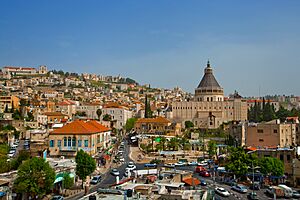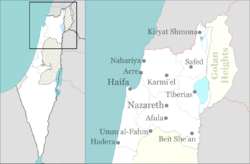Nazareth facts for kids
Quick facts for kids
Nazareth
النَّاصِرَة, an-Nāṣira
נָצְרַת, Nāṣrat
|
||
|---|---|---|

View of Nazareth, with the Basilica of the Annunciation at the center
|
||
|
||
| Country | ||
| District | Northern | |
| Founded |
|
|
| Municipality | Est. 1885 | |
| Government | ||
| • Type | Mayor–council | |
| • Body | Municipality of Nazareth | |
| Area | ||
| • Total | 14.123 km2 (5.453 sq mi) | |
| Elevation | 347 m (1,138 ft) | |
| Population
(2017)
|
76,551 | |
| Demonym(s) | Nazarene | |
| Ethnicity | ||
| • Arabs | 99.8% | |
| • Jews and others | 0.2% | |
| Time zone | UTC+2 (IST) | |
| • Summer (DST) | UTC+3 (IDT) | |
| Area code | +972 (Israel) | |
Nazareth is a large city in the Northern District of Israel. It is often called "the Arab capital of Israel." This is because it is a major cultural, political, religious, and economic center for Arab citizens of Israel. Most of its people are Arab citizens of Israel. About 69% are Muslim and 30.9% are Christian.
Nazareth is also very important for religious reasons. It is known as the hometown of Jesus. Jesus is the main figure in Christianity and an important prophet in Islam.
Contents
History of Nazareth
Early Beginnings
People lived in the area around Nazareth a very long time ago. Findings from the nearby Qafzeh Cave show that people were here in prehistoric times. Later, Nazareth was a small Jewish village during the Roman and Byzantine periods. The New Testament says it was where Jesus grew up.
Crusades and Later Years
Nazareth became an important city during the Crusades. This was after a leader named Tancred made it the capital of the Principality of Galilee. The city became less important under the Mamluk rulers. When the Ottomans took over, Christian residents were asked to leave. They were later allowed to return.
In the 1700s, Zahir al-Umar helped Nazareth grow. He encouraged more people to move there. The city kept growing in the late 1800s and early 1900s. European countries helped build churches, monasteries, schools, and hospitals.
Religious Importance
Nazareth has been a popular place for Christian pilgrimage for a very long time. Many holy sites here remember events from the Bible.
Church of the Annunciation
The Church of the Annunciation is one of the biggest Christian places of worship in the Middle East. Inside, there is a special cave called the Grotto of the Annunciation. According to Catholic belief, this is where the angel Gabriel appeared to Mary. He told her that she would have a son, Jesus.
Other Important Churches
The Greek Orthodox Church of the Annunciation, also known as Church of Saint Gabriel, is another important site. Greek Orthodox Christians believe the same event happened here. Other important churches in Nazareth include the Synagogue Church and St. Joseph's Church. You can also find the Mensa Christi Church and the Basilica of Jesus the Adolescent here.
Meaning of the Name
The name 'Nazareth' has a few possible meanings. One idea is that it comes from a Hebrew word for 'branch' (netzer). This word is mentioned in an old prophecy about a new leader.
Another idea is that the name comes from a Hebrew word meaning 'watch' or 'guard' (na·ṣar). This could mean Nazareth was a 'watchtower' or a 'guard place'. It might also mean it was a 'protected' place because of its hidden location.
The Arabic name for Nazareth is an-Nāṣira. Jesus is sometimes called an-Nāṣirī. This means "the one from Nazareth." In the Qur'an, Christians are called naṣārā. This means "followers of Jesus of Nazareth."
See also
 In Spanish: Nazaret para niños
In Spanish: Nazaret para niños




